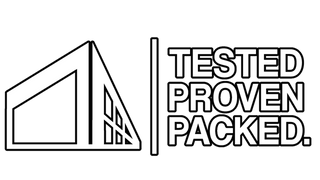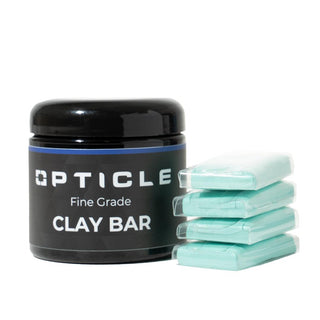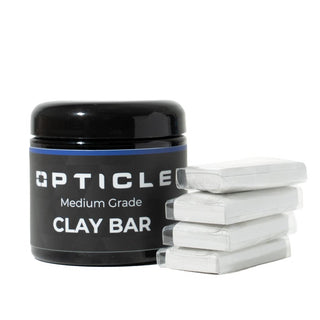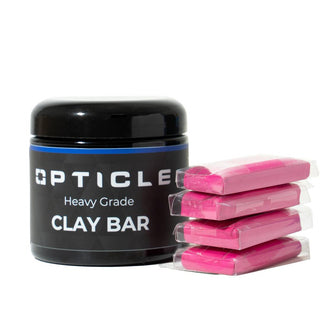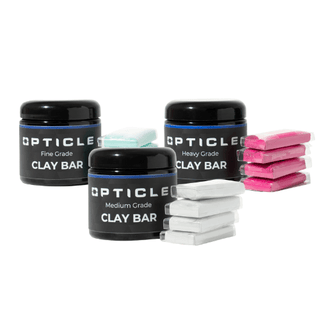Clay Bar – Essential for Surface Decontamination in Automotive Detailing and Film Applications
A clay bar is a crucial tool in the detailing and film installation industry, designed to remove embedded contaminants from a vehicle's paint, glass, and even metal surfaces. Although washing a car can remove surface-level dirt, it often leaves behind contaminants like brake dust, industrial fallout, tree sap, tar, and other particles that bond to the vehicle’s surface. These contaminants, if left untreated, can lead to imperfections in the paint, reduced gloss, and, more importantly for film installers, interfere with the adhesion of products like paint protection film (PPF) or vinyl wraps.
Using a clay bar is a highly effective method to decontaminate the surface, leaving it smooth and free from these impurities. This step is essential to achieving a flawless finish in both detailing and film installation, as well as ensuring the longevity of the protective coatings or films applied to the vehicle.
How Clay Bars Work:
Clay bars are made from a synthetic resin compound that’s malleable, allowing it to conform to the surface of the vehicle. When used with proper lubrication, the clay bar safely lifts contaminants from the paint’s surface without scratching or damaging the clear coat.
Steps to Properly Use a Clay Bar:
-
Wash the Car:
- Begin by thoroughly washing the vehicle with a pH-neutral car shampoo to remove loose dirt, dust, and grime. Dry the vehicle completely before proceeding to the claying step.
- Importance: Removing surface debris before claying prevents rubbing dirt into the paint, which could cause scratches.
-
Lubricate the Surface:
- Spray a generous amount of clay lubricant (or a quick detailer spray) onto a small section of the car. This lubrication is crucial to reducing friction between the clay bar and the paint surface, ensuring smooth movement and preventing damage to the clear coat.
- Tip for Film Installers: For those applying PPF or vinyl wraps, make sure the surface is adequately lubricated, as clay can help remove stubborn contaminants that washing alone won't.
-
Clay the Surface:
- Gently rub the clay bar back and forth over the lubricated area using light pressure. You’ll feel the clay pick up and pull contaminants from the surface. Continue working in a small area until the clay glides effortlessly across the paint, indicating the removal of bonded particles.
- Important Note: Avoid applying too much pressure. Let the clay bar do the work by gently lifting contaminants. Excessive force can lead to marring or light scratches, especially on delicate surfaces.
-
Knead the Clay:
- After working an area, fold and knead the clay bar to expose a clean section before moving on to the next part of the vehicle. This prevents reintroducing contaminants to the paint and ensures effective decontamination.
- Pro Tip: If the clay becomes too contaminated, it’s time to replace it to avoid causing damage to the surface.
-
Wipe the Surface Clean:
- After claying each section, use a microfiber towel to wipe the area clean and remove any residue left behind by the lubricant or the clay itself.
- Film Application Tip: Make sure the surface is completely residue-free before proceeding with film application. Any remaining residue can affect the adhesion and finish of the film.
-
Check Your Progress:
- Repeat the process over the entire vehicle, working in small sections. Afterward, gently run your hand or a plastic bag over the paint to check for any remaining contaminants. The surface should feel smooth and glass-like when fully decontaminated.
Why Clay Bar Decontamination is Essential for Detailing and Film Installation:
-
Surface Preparation:
- In both detailing and film installation, the condition of the surface is key to achieving a professional finish. A contaminated surface can lead to paint imperfections, visible particles under PPF or vinyl wraps, and reduced effectiveness of protective coatings.
- PPF/Vinyl Wraps: For film applications, clay barring ensures that no microscopic contaminants interfere with film adhesion, minimizing the risk of lifting or bubbling.
-
Enhanced Paint Clarity and Gloss:
- By removing embedded contaminants, a clay bar restores smoothness to the paint, which enhances the clarity and depth of the vehicle’s finish. This is especially important before polishing or applying ceramic coatings, which require a contaminant-free surface for proper bonding and maximum gloss.
- Detailing Tip: After claying, applying a wax or sealant locks in the smoothness and adds additional protection.
-
Prevents Long-Term Paint Damage:
- Contaminants left on the surface for extended periods can embed themselves further into the paint, potentially causing oxidation or even paint failure. Regular clay bar treatments help prevent this by safely removing these particles.
- Film Installers: Ensuring the surface is decontaminated with a clay bar before PPF or vinyl wrap application prevents paint damage that could affect the quality of the film over time.
-
Improved Coating and Film Longevity:
- For PPF, vinyl wraps, and ceramic coatings, surface preparation is critical to ensuring these products adhere properly and perform to their maximum potential. A smooth, contaminant-free surface allows for better adhesion, preventing premature failure, lifting, or peeling.
- For Coatings: Proper surface decontamination ensures a stronger bond between the ceramic coating and the paint, resulting in longer-lasting protection.
Clay Bar Types and Grades:
- Light-Grade Clay: Ideal for routine maintenance on well-maintained vehicles with minor surface contaminants.
- Medium-Grade Clay: Best suited for vehicles with moderate contamination, like road tar, tree sap, or industrial fallout, often used in pre-detailing prep.
- Heavy-Grade Clay: Reserved for vehicles with significant contamination that have been exposed to harsh environmental conditions for extended periods.
In the detailing and film installation industry, choosing the right grade of clay ensures you’re using the appropriate tool for the specific level of contamination.
Earn [points_amount] when you buy this item.
OPTICLE Clay Bar For Cars | (4) 50g Individual Packs with Canister
- Unit price
- /per
Free shipping over $125. Code: FREESHIP
Earn Reward Points With Every Order
Pairs well with
Your details are protected and safe with us.
Adding product to your cart
Clay Bar – Essential for Surface Decontamination in Automotive Detailing and Film Applications
A clay bar is a crucial tool in the detailing and film installation industry, designed to remove embedded contaminants from a vehicle's paint, glass, and even metal surfaces. Although washing a car can remove surface-level dirt, it often leaves behind contaminants like brake dust, industrial fallout, tree sap, tar, and other particles that bond to the vehicle’s surface. These contaminants, if left untreated, can lead to imperfections in the paint, reduced gloss, and, more importantly for film installers, interfere with the adhesion of products like paint protection film (PPF) or vinyl wraps.
Using a clay bar is a highly effective method to decontaminate the surface, leaving it smooth and free from these impurities. This step is essential to achieving a flawless finish in both detailing and film installation, as well as ensuring the longevity of the protective coatings or films applied to the vehicle.
How Clay Bars Work:
Clay bars are made from a synthetic resin compound that’s malleable, allowing it to conform to the surface of the vehicle. When used with proper lubrication, the clay bar safely lifts contaminants from the paint’s surface without scratching or damaging the clear coat.
Steps to Properly Use a Clay Bar:
-
Wash the Car:
- Begin by thoroughly washing the vehicle with a pH-neutral car shampoo to remove loose dirt, dust, and grime. Dry the vehicle completely before proceeding to the claying step.
- Importance: Removing surface debris before claying prevents rubbing dirt into the paint, which could cause scratches.
-
Lubricate the Surface:
- Spray a generous amount of clay lubricant (or a quick detailer spray) onto a small section of the car. This lubrication is crucial to reducing friction between the clay bar and the paint surface, ensuring smooth movement and preventing damage to the clear coat.
- Tip for Film Installers: For those applying PPF or vinyl wraps, make sure the surface is adequately lubricated, as clay can help remove stubborn contaminants that washing alone won't.
-
Clay the Surface:
- Gently rub the clay bar back and forth over the lubricated area using light pressure. You’ll feel the clay pick up and pull contaminants from the surface. Continue working in a small area until the clay glides effortlessly across the paint, indicating the removal of bonded particles.
- Important Note: Avoid applying too much pressure. Let the clay bar do the work by gently lifting contaminants. Excessive force can lead to marring or light scratches, especially on delicate surfaces.
-
Knead the Clay:
- After working an area, fold and knead the clay bar to expose a clean section before moving on to the next part of the vehicle. This prevents reintroducing contaminants to the paint and ensures effective decontamination.
- Pro Tip: If the clay becomes too contaminated, it’s time to replace it to avoid causing damage to the surface.
-
Wipe the Surface Clean:
- After claying each section, use a microfiber towel to wipe the area clean and remove any residue left behind by the lubricant or the clay itself.
- Film Application Tip: Make sure the surface is completely residue-free before proceeding with film application. Any remaining residue can affect the adhesion and finish of the film.
-
Check Your Progress:
- Repeat the process over the entire vehicle, working in small sections. Afterward, gently run your hand or a plastic bag over the paint to check for any remaining contaminants. The surface should feel smooth and glass-like when fully decontaminated.
Why Clay Bar Decontamination is Essential for Detailing and Film Installation:
-
Surface Preparation:
- In both detailing and film installation, the condition of the surface is key to achieving a professional finish. A contaminated surface can lead to paint imperfections, visible particles under PPF or vinyl wraps, and reduced effectiveness of protective coatings.
- PPF/Vinyl Wraps: For film applications, clay barring ensures that no microscopic contaminants interfere with film adhesion, minimizing the risk of lifting or bubbling.
-
Enhanced Paint Clarity and Gloss:
- By removing embedded contaminants, a clay bar restores smoothness to the paint, which enhances the clarity and depth of the vehicle’s finish. This is especially important before polishing or applying ceramic coatings, which require a contaminant-free surface for proper bonding and maximum gloss.
- Detailing Tip: After claying, applying a wax or sealant locks in the smoothness and adds additional protection.
-
Prevents Long-Term Paint Damage:
- Contaminants left on the surface for extended periods can embed themselves further into the paint, potentially causing oxidation or even paint failure. Regular clay bar treatments help prevent this by safely removing these particles.
- Film Installers: Ensuring the surface is decontaminated with a clay bar before PPF or vinyl wrap application prevents paint damage that could affect the quality of the film over time.
-
Improved Coating and Film Longevity:
- For PPF, vinyl wraps, and ceramic coatings, surface preparation is critical to ensuring these products adhere properly and perform to their maximum potential. A smooth, contaminant-free surface allows for better adhesion, preventing premature failure, lifting, or peeling.
- For Coatings: Proper surface decontamination ensures a stronger bond between the ceramic coating and the paint, resulting in longer-lasting protection.
Clay Bar Types and Grades:
- Light-Grade Clay: Ideal for routine maintenance on well-maintained vehicles with minor surface contaminants.
- Medium-Grade Clay: Best suited for vehicles with moderate contamination, like road tar, tree sap, or industrial fallout, often used in pre-detailing prep.
- Heavy-Grade Clay: Reserved for vehicles with significant contamination that have been exposed to harsh environmental conditions for extended periods.
In the detailing and film installation industry, choosing the right grade of clay ensures you’re using the appropriate tool for the specific level of contamination.
